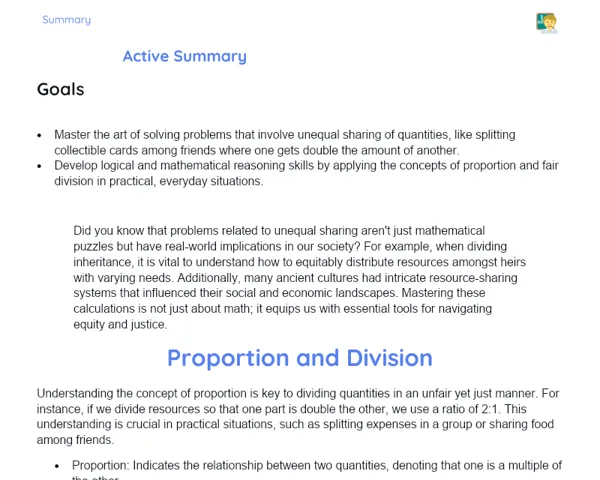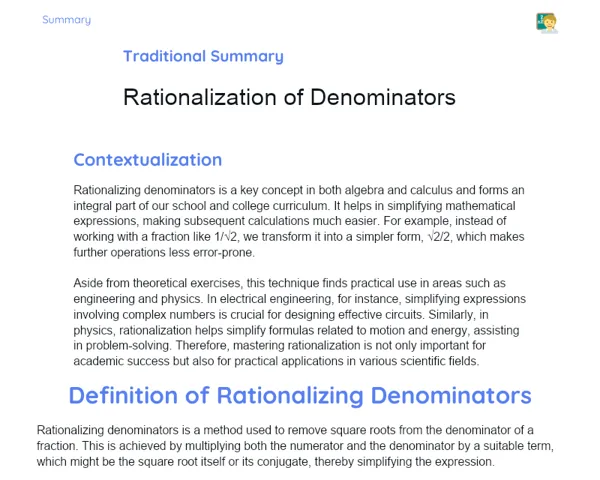Goals
1. Understand the concept of rationalizing denominators in fractions.
2. Develop the skill to eliminate square roots from the denominators of fractions.
3. Apply the technique of rationalization in practical mathematical problems.
Contextualization
Rationalizing denominators is a useful mathematical technique that simplifies fractions by getting rid of square roots in the denominator. For instance, when we rationalize 1/√2, we end up with √2/2. This technique holds great significance in various fields, such as engineering and the exact sciences, where precise calculations are paramount. For example, in electrical circuits, rationalization aids in managing frequencies, while in physics, it simplifies complex equations, ensuring greater clarity and accuracy in results.
Subject Relevance
To Remember!
Concept of Rationalizing Denominators
Rationalizing denominators refers to a mathematical method used to eliminate square roots from the denominator of a fraction. This is achieved by multiplying both the numerator and denominator by an expression designed to remove the root from the denominator.
-
Removes square roots from the denominator.
-
Simplifies the fraction for easier calculations.
-
Enhances the precision and clarity of mathematical expressions.
Elimination of Square Roots from the Denominator
To eliminate square roots from the denominator, we multiply the original fraction by an equivalent fraction which will remove the square root in the denominator. For instance, to rationalize 1/√2, we multiply by √2/√2, resulting in √2/2.
-
Multiplication by an equivalent fraction.
-
Utilization of radical properties to simplify expressions.
-
Converting irrational denominators into rational ones.
Application of the Rationalization Technique
The rationalization technique can be applied to various mathematical problems to simplify the resolution of equations and enhance the accuracy of results. It is particularly beneficial in calculations involving fractions with radicals.
-
Simplifying complex mathematical expressions.
-
Enhancing accuracy in scientific and engineering calculations.
-
Facilitating the manipulation of mathematical expressions.
Practical Applications
-
Civil Engineering: Streamlining structural calculations to ensure project accuracy and safety.
-
Computer Graphics: Optimizing image rendering procedures to boost algorithm efficiency.
-
Physics: Simplifying expressions in mechanics and electrical problems for easier analysis and interpretation.
Key Terms
-
Rationalization: A mathematical approach to remove square roots from the denominator of a fraction.
-
Fraction: A representation of a part of a whole, expressed as the ratio of two numbers.
-
Square Root: A number which, when multiplied by itself, gives the original number.
Questions for Reflections
-
How could the ability to rationalize denominators impact accuracy and efficiency in fields involving extensive calculations like engineering, physics, and computer science?
-
What challenges have you faced when using the rationalization technique, and how did you tackle them?
-
In what practical ways can rationalizing denominators be applicable beyond the classroom, in real-life situations?
Practical Challenge: Simplifying Fractions with Square Roots
This mini-challenge aims to reinforce the understanding of the rationalizing denominators technique, providing you an opportunity to practice eliminating square roots from the denominators of fractions.
Instructions
-
Team up with a classmate.
-
Each pair should select five fractions that feature square roots in the denominators.
-
Utilize the rationalization technique on each of your selected fractions.
-
Each individual in the pair should explain the rationalization method used for each fraction to their partner.
-
Swap fractions with another pair and verify if the rationalization was executed correctly.
-
Discuss the outcomes and offer feedback on the processes employed.



